The King's Arms
19th Century
The building that was once a public house, The King's Arms, is located on the corner
of Pembroke and George Streets, at postcode PL1 4JS. According to
English Heritage it was built in the late 19th century.
However, I have a suspicion that dating is wrong, for two reasons; one is that a
queen was on the throne at that time, yet the pub is called The King's Arms; the
other, stronger reason, is that it is listed in Pigot's Directory of 1830. The directory
identifies the public house by its name, gives the correct address and number in
Pembroke Street, and names the landlord that year as Francis Dorrington. In 1830
a king was on the throne, hence the pub's name making more sense. Therefore, this
ex public house may have been built early 19th century, not late, as is documented
(but see a second interpretation below, under the 20th century).
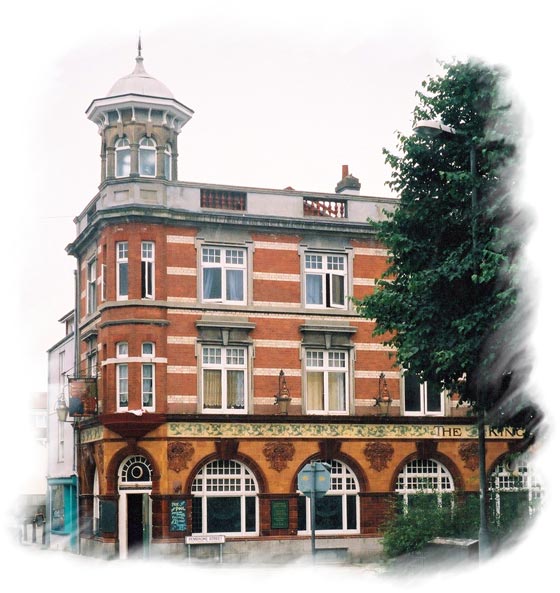 The King's Arms, on the corner of George/Pembroke Streets,
Devonport
The King's Arms, on the corner of George/Pembroke Streets,
Devonport
It is a striking looking building, with numerous features, those immediately observed
are its colour, the arched windows, and the turret.
On close inspection you will see the lovely glazed tiles, a deep, moulded coloured
frieze running the full length of the building, and what appears to be a royal herald
repeated between each window. The next photo captures several of these details in
one image.
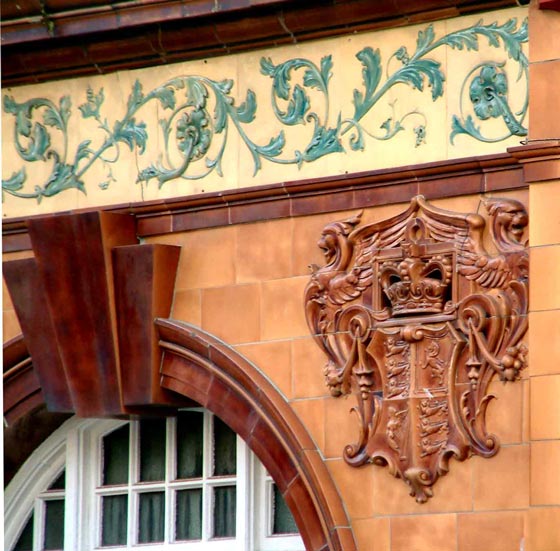 Detail of The King's Arms
Detail of The King's Arms
The Pub Sign
The pub sign, last seen displayed in 2004, was identical to the shield section of
the UK royal coat of arms - it contained three passant guardant lions of England
in the first and fourth quarters; the rampant lion of Scotland in the second, and
a harp for Northern Ireland in the third quarter. Below is an image of the actual
shield on the uk coat of arms - which is virtually the same as the pub sign used
to be. The text across the top of the sign reads, The King's Arms. The sign is just
visible, on the left of the first image above, which I took in 2004.
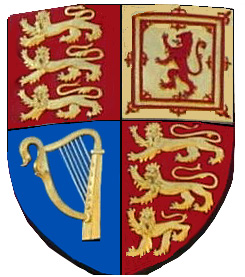
Heraldic Panels
The shield section of the eight heraldic-like panels, in between the windows, is
the same as the pub sign was, thus, the shield part of the panel is definitely royal.
Whether the full panel is royal is best decided by others who know such things.
The best I can do here is to say it's as near as... The crown on top of the crest
is correct, that too forms part of the official UK arms. The only difference I can
see is the supporting creatures, to the left and right. In this case it appears
to be some form of dragon with wings, whereas on the official arms the supporting
creatures are a lion and a unicorn.
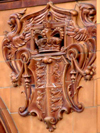
The fact that there are different supporting creatures on the heraldic arms on this
building does not necesarily mean it is not valid. The then king at the time it
was built (should that interpretation be correct), might well have granted the right
to display Royal Arms. Various members of the royal family have had different supporting
creatures; bulls, boars and stags have variously been used, so it's not unusual.
Without knowing precisely, my thoughts are that the panels are valid (as opposed
to being invented as a design feature), that it matters not about the dragons, and
that permission to use the Royal Arms was indeed granted by a monarch. But which
one? Perhaps Prince William frequented the pub on occasion, while he was in the
navy and here in Devonport, then when he became King William IV, in 1830, he granted
his permission formally... or perhaps it was King Edward VII that granted permission
in the following century, see next section. (The reason I don't believe it was Queen
Victoria who may have granted permission is again because of the pub's name - it
just doesn't fit with the rest of the clues)
20th Century
When the 20th century arrived the pub was being run by John Martin and later his
son James Martin. According to Winston Guy, they ran it between 1873 and 1913. While
John Martin was running the pub, the owner of the building, in 1902, was John Nodder.
Nodder applied for planning permission to rebuild it, which was approved on 1st September
1902. The architect for this work was Edgar M Leest (who, the year before, was the
Mayor of Devonport). Plymouth & West Devon Record Office holds the plans for the
rebuild (Ref: PCC/60/1/859), including foundation plan, ground floor plan, first
floor plan, second floor plan and roof plan. The extent to which the rebuild was
carried out, if at all, is unknown by this author, the plans have not been examined.
If the rework to the building
was carried
out, the date of 1902 may hold some significance - it was the year King Edward VII
was crowned. With regard to the validity of the pub's beautiful heraldic panels,
they could well have been made in celebration of the coronation, and later sanctioned
by the king. This would fit with the rebuild, and the need for the public house
to present its new face.
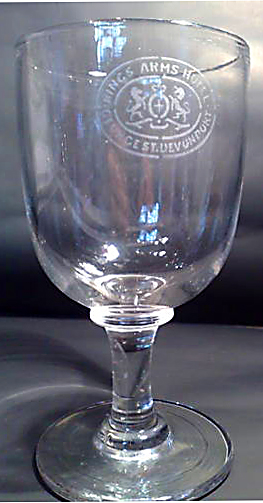
A glass from earlier times, probably early 2oth century,
when the building was a public house. The text on the glass is ... Kings Arms Hotel,
George St, Devonport.
Listed Status
The King's Arms became a Grade II listed building, through English Heritage, on 9th
November 1998.
21st Century
By 2005 Plymouth City Council had included the property in its Buildings at Risk
Register (BAR); both the pub, number 60 and the adjoining property, number 61,
were placed on the BAR at the same time.
The King's Arms ceased functioning as a public house in early 2005.
In May 2005 The King's Arms was offered for sale at a Taylor Son & Creber auction, it was
described as ... 'A character Grade II Listed three storey, most recently a mixed
commercial and residential investment property now available for redevelopment,
subject to any requisite consents, located in the heart of Devonport comprising
a ground floor public house with a basement cellar and two upper floors of eight
bedroomed residential accommodation.'
During 2005 the pub suffered a couple of fires, with firefighters being called out
both times, on one occasion in November the ground floor was significantly damaged;
on another occasion a chimney was said to be 'well alight', and an aerial ladder
platform had to be used by the firefighters.
Late in 2005 planning permission (Ref 05/01828/LBC) was sought to convert the ground
floor into a self-contained flat, however, the application was withdrawn (Ref 05/01826/FUL)
in December 2005.
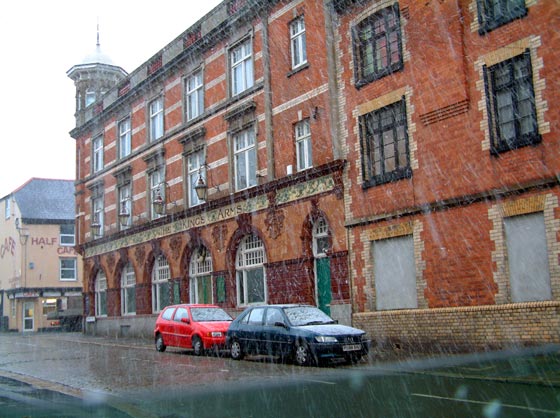 The King's Arms - photographed from Pembroke Street while it was snowing.
The King's Arms - photographed from Pembroke Street while it was snowing.
Refs:
- Pigot's Directory of 1830
-
British Listed Buildings
- Plymouth
Buildings at Risk Register
- PCC Planning - (PCC/60/1/859), (05/01826/FUL) and (05/01828/LBC)
- Winston Guy.
Three Towns Bottles, 2005. Available on CD.
(Liz Cook. Page added 7th March 2011. Updated July 2011)